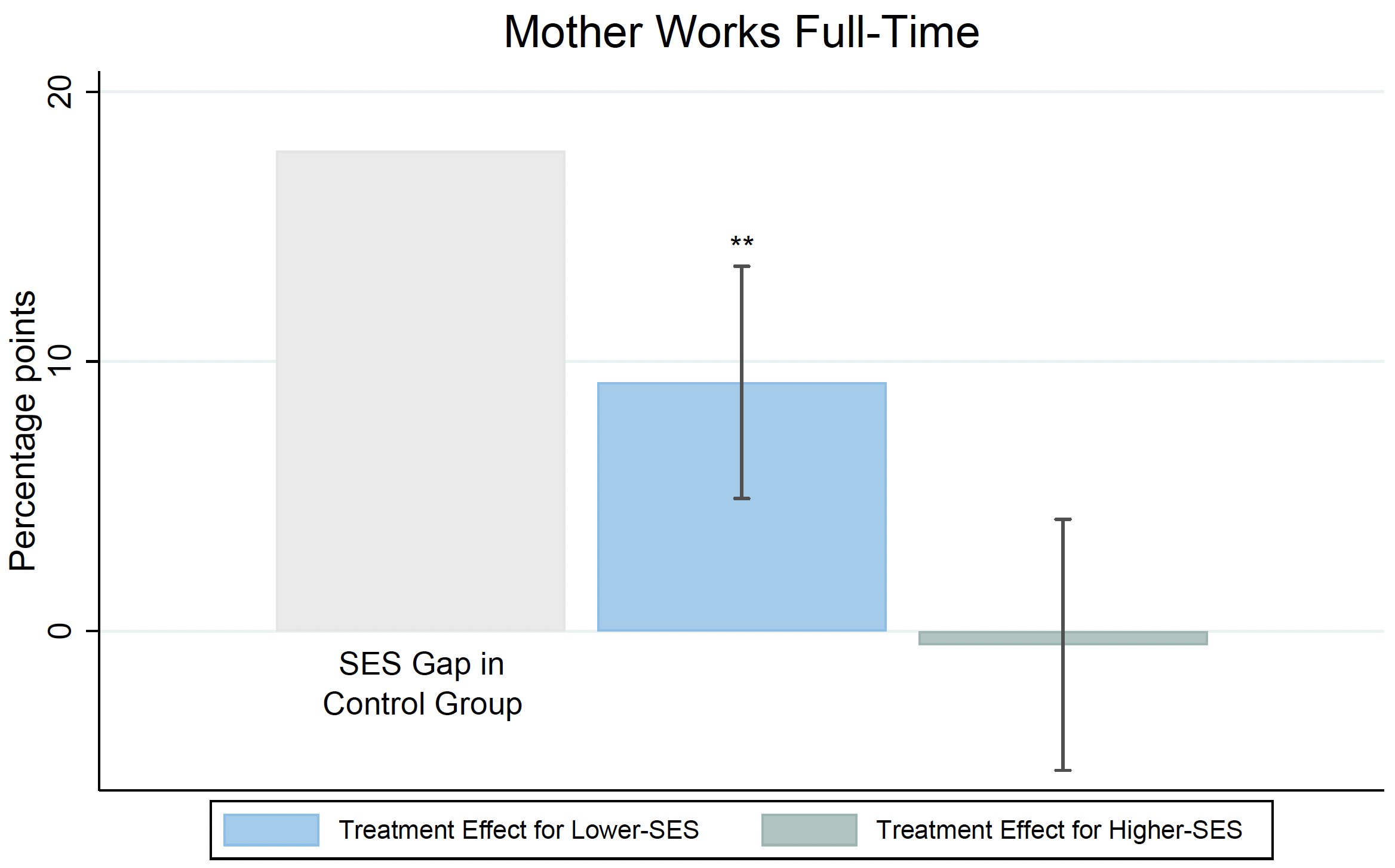The arrival of children tends to have persistent negative effects on the labour market outcomes of mothers, but no effect on the labour market outcomes of fathers (Washington et al. 2018, Kleven et al. 2019, Andresen and Nix 2022a, 2022b). This disparity is driven largely by the fact that mothers still take on most of the childcare duties. To reduce maternal childcare duties and promote maternal labour supply, many countries have introduced public provision of childcare targeted at all children (‘universal childcare’) and increased the number of available slots.
Previous literature shows positive effects of expansions of universal early childcare on maternal labour supply in various countries (Rizzica and Carta 2018, Andresen and Havnes 2019), including Germany (Müller and Wrohlich 2020). However, the benefits of (expanding) universal early childcare differ strongly by a mother’s socioeconomic status (SES). Mothers with lower SES might have difficulties obtaining a childcare slot because they must compete for slots with other (higher-SES) families and application processes are complex (Hermes et al. 2021a). Accordingly, they often benefit less from childcare expansions than higher-SES mothers in terms of their labour supply (Müller and Wrohlich 2020). This pattern is important, as labour market outcomes of disadvantaged mothers are particularly negatively affected by childbirth.
In a field experiment, we enable lower-SES mothers in Germany to use universal early childcare by providing information and help on childcare applications (Hermes et al. 2022). In particular, we show that information provision and personal assistance improves labour market success for lower-SES mothers, including full-time employment and household income. It also promotes intra-household gender equality.
Maternal labour supply in Germany and study design
In Germany, the negative impact of children on mothers’ labour market outcomes is stronger than in most other industrialised countries and, relatedly, gender gaps in the labour market are particularly large (OECD 2017, Kleven et al. 2019, Feldhoff 2021). To increase maternal (full-time) employment rates, Germany has greatly expanded its universal childcare system since the mid-1990s (von der Leyen 2008, Education Report 2020). However, parental demand for slots still exceeds supply, and lower-SES families are strongly underrepresented in early childcare (Jessen et al. 2020).
We conducted a large-scale field experiment in two cities in Germany. A total of 607 families with children aged zero to one year participated. Following previous literature on maternal labour supply (e.g. Dujardin et al. 2018, Müller and Wrohlich 2020), we define SES based on education. We classify mothers without a college entrance qualification as ‘lower SES’, while mothers with such qualification are classified as ‘higher SES’. The share of lower-SES mothers in our sample is about 40%, which reflects the educational distribution of mothers with young children in Germany.
The treatment was designed to enable lower-SES families to access childcare, but not to persuade parents to enrol their child in childcare or to change maternal work plans. It included two components: information provision and customised application assistance.
First, to address a potential lack of parental knowledge about the childcare application process, we showed each parent in the treatment group a four-minute information video immediately after completing the baseline interview. Second, we offered parents in the treatment group personal application assistance from trained research assistants. This personalised support included help with filling out forms and reminders about important deadlines.
In contrast, the parents in the control group received neither information nor personal application assistance. Randomising families into treatment and control groups allows us to estimate the causal effect that enabling families to access universal early childcare has on maternal labour market outcomes (i.e. the treatment effect).
Key finding: Lower-SES mothers benefit strongly from easier access to early childcare
Nine months after the treatment, we found large effects on childcare enrolment of lower-SES children (Hermes et al. 2021b). The probability of attending childcare increased by 16 percentage points for these children compared to the control group, which did not receive support in the childcare application process. The treatment did not affect enrolment of higher-SES children.
Our main results are presented in Figure 1. The graph shows treatment effects on the probability of working full-time separately for lower- and higher-SES mothers.
Figure 1 Treatment effects on maternal full-time employment
Notes: The figure depicts the effect of enabling access to early childcare on full-time employment of lower- and higher-SES mothers. To benchmark the effect size, the grey bar shows the difference in full-time employment rates between lower- and higher-SES mothers. Error bars show robust standard errors. Significance levels: * p<.10, ** p<.05, *** p<.01.
The figure shows that 18 months after the treatment, when children were 2–3 years old, treated lower-SES mothers were nine percentage points more likely to work full-time (blue bar). In the control group, only 6% of lower-SES mothers worked full-time, which implies that our treatment increased full-time employment by more than 150%. Our treatment cut the SES gap in full-time employment (grey bar) by half, since we did not find an effect for higher-SES mothers (green bar).
Our results suggest that a sizable share of lower-SES mothers would like to work full-time, but are unable to do so because of barriers to access to universal early childcare. In fact, the treatment effect on full-time employment is driven by mothers who stated at the beginning of the study (i.e. prior to the treatment) that they planned to return to work after childbirth. In line with the positive effect on full-time employment, the household income of lower-SES families increased by 10% due to the treatment. This implies that the increase in maternal full-time employment was not compensated for by a corresponding decrease in fathers’ labour supply.
We also found that our treatment improved gender equality within lower-SES households. First, the treatment reduced gender gaps in both full-time employment and earnings. Intriguingly, we also observe an increase in care hours provided by the father, suggesting that gender gaps in paid and unpaid work are strongly related. These findings emphasise the importance of access to universal childcare to move towards a more gender-equal society.
Discussion and policy implications
Our findings suggest that enabling access to universal early childcare is an effective policy tool for increasing full-time employment rates and household income of lower-SES mothers, a group that is particularly disadvantaged in the labour market. Activating the working potential of these mothers seems more important than ever, considering the immense labour shortage in ageing societies such as Germany. Moreover, better access to universal early childcare leads to more childcare hours provided by fathers, improving gender equality in paid and unpaid work in lower-SES households. Therefore, access to universal childcare can accelerate the transition to a more gender-equal society.
Our results also have implications for the effective design of social programmes in general. The complexity of administrative procedures can be a major barrier to accessing social benefits and entering educational programmes, especially for lower-SES individuals (see e.g. Currie 2004, Walters 2018, Hermes et al. 2021, Ko and Moffitt 2022). We demonstrate that removing such barriers promotes the childcare take up of lower-SES families and yields large benefits by improving mothers’ labour market opportunities and gender equality in the household. Our evidence not only highlights the need for policymakers to increase the availability of childcare slots, but also underscores the importance of structural reforms aimed at reducing application barriers to fully realise the societal benefits of universal early childcare programmes.
References
Andresen, M E and T Havnes (2019), “Child care, parental labor supply and tax revenue”, Labour Economics 61: 101762.
Andresen, M E and E Nix (2022a), “Can the child penalty be reduced? Evaluating multiple policy interventions”, Statistics Norway Research Department Discussion Papers 983.
Andresen, M E and E Nix (2022b), “What causes the child penalty? Evidence from adopting and same sex couples”, Journal of Labor Economics 40(4): 971–1004.
Ursula von der Leyen (2008), “Der Weg zum Ausbau der Kinderbetreuung ist frei”, technical report, Bundesministerium für Familien, Senioren, Frauen und Jugend (BMFSFJ, German Ministry of Family Affairs).
Currie, J (2004), “The take up of social benefits”, NBER Working Paper 10488.
Dujardin, C, M Fonder and B Lejeune (2018), “Does formal child care availability for 0–3 year olds boost mothers’ employment rate? Panel data based evidence from Belgium”, Annals of Economics and Statistics 129: 103–126.
Education Report (2020), “Autorengruppe Bildungsberichterstattung: Bildung in Deutschland 2020. Ein indikatorengestützter Bericht mit einer Analyse zur Bildung in einer digitalisierten Welt”.
Feldhoff, C H (2021), “The child penalty: Implications of parenthood on labour market outcomes for men and women in Germany”, SOEPpapers on Multidisciplinary Panel Data Research 1120.
Hermes, H, P Lergetporer, F Peter and S Wiederhold (2021a), “Behavioral barriers and the socioeconomic gap in child care enrollment”, CESifo Working Paper 9282.
Hermes, H, P Lergetporer, F Peter and S Wiederhold (2021b), “The socioeconomic gap in childcare enrolment: The role of behavioural barriers”, VoxEU.org, 7 December.
Hermes, H, M Krauß, P Lergetporer, F Peter and S Wiederhold (2022), “Early child care and labor supply of lower-SES mothers: A randomized controlled trial”, CESifo Working Paper 10178.
Jessen, J, S Schmitz and S Waights (2020), “Understanding day care enrolment gaps”, Journal of Public Economics 190: 104252.
Kleven, H, C Landais, J Posch, A Steinhauer and J Zweimüller (2019), “Child penalties across countries: Evidence and explanations”, AEA Papers and Proceedings 109: 122–26.
Ko, W and R A Moffitt (2022), “Take-up of social benefits”, NBER Working Paper 30148.
Müller, K U and K Wrohlich (2020), “Does subsidized care for toddlers increase maternal labor supply? Evidence from a large-scale expansion of early childcare”, Labour Economics 62: 101776.
OECD (2017), The pursuit of gender equality: An uphill battle, OECD, Paris.
Rizzica, L and F Carta (2018), “Subsidising childcare: A boost to female labour supply with no adverse consequences for children”, VoxEU.org, 26 June.
Walters, C R (2018), “The demand for effective charter schools”, Journal of Political Economy 126(6): 2179–223.
Washington, E, J Pan, J Shen and I Kuziemko (2018), “Women's anticipation of the employment effects of motherhood: Evidence and implication”, VoxEU.org, 22 September.









